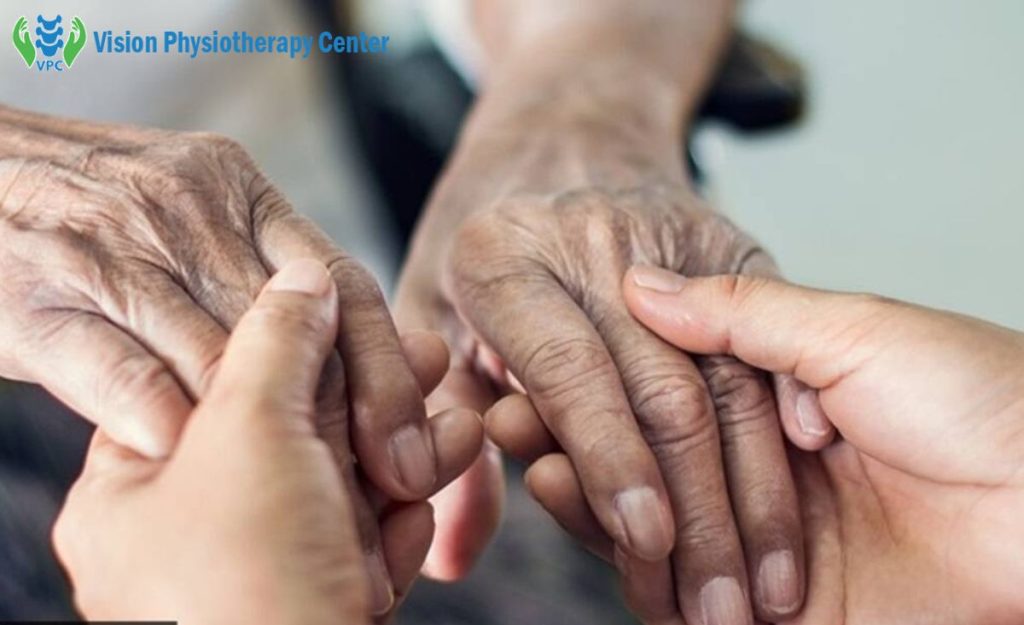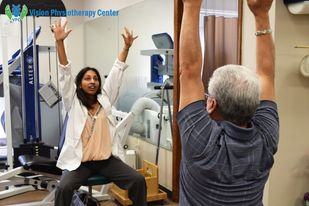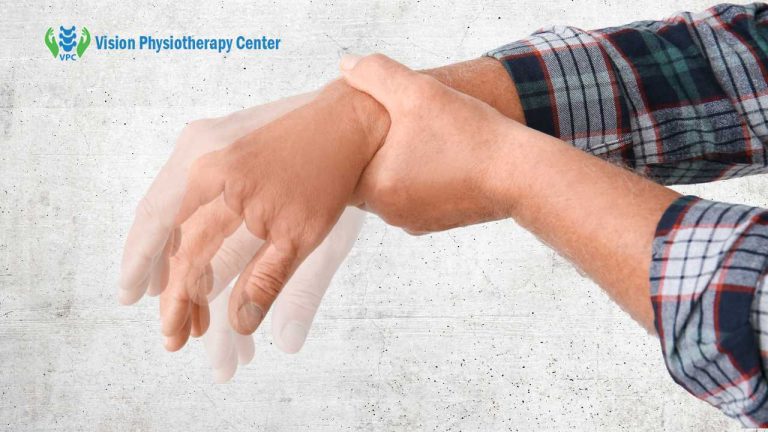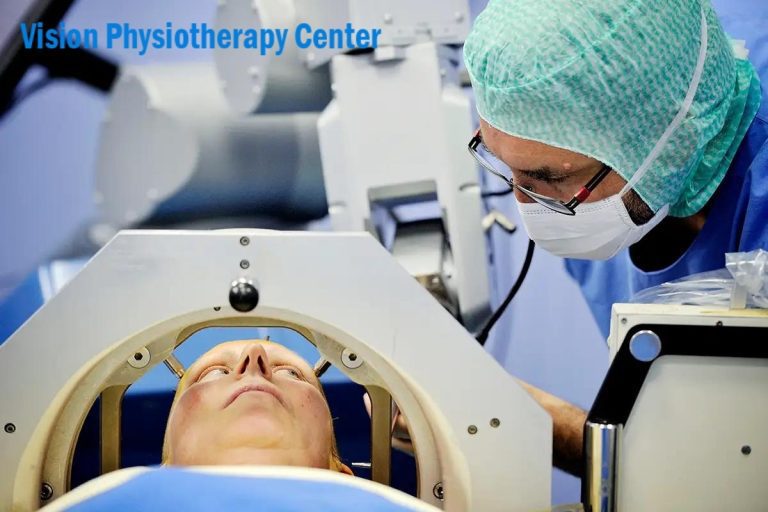Introduction
Parkinson’s Disease is a neurodegenerative disorder that affects the movement of the body. It is characterized by tremors, stiffness, and difficulty with balance and coordination. As the disease progresses, it can have a significant impact on the patient’s quality of life, making it difficult to perform daily activities such as walking, dressing, and eating.
What is The Role of Physiotherapist in Parkinson Disease? The management of Parkinson’s Disease. It can help improve the patient’s mobility, balance, and coordination, and reduce the risk of falls and injuries. Physiotherapists work with patients to develop exercise programs tailored to their specific needs and abilities and provide ongoing support and encouragement throughout the course of Parkinson Disease treatment. The goal of physiotherapy is to help patients maintain their independence and improve their overall quality of life.
Symptoms of Parkinson’s Disease
Parkinson’s Disease is a progressive disorder that affects the nervous system and movement of the body. The symptoms of Parkinson’s Disease can vary from person to person, but some of the most common ones include
- Tremors: involuntary shaking of the hands, arms, legs, jaw, or face
- Stiffness: rigidity of the muscles, which can make movement difficult and slow
- Bradykinesia: Slowness of movement, making it difficult to perform simple tasks such as getting dressed or brushing teeth
- Postural instability: difficulty with balance and coordination, which can increase the risk of falls and injuries
- Loss of smell: a decreased ability to smell or taste
- Depression and anxiety: emotional changes that can be associated with Parkinson’s Disease.
These symptoms can significantly impact the patient’s quality of life, making it difficult to perform activities of daily living. For example, tremors can make it hard to hold objects, while stiffness can make it difficult to move around. Postural instability can make it hard to walk, climb stairs, or even stand up from a chair. The loss of smell can affect the patient’s enjoyment of food and impact their appetite. Depression and anxiety can make it hard to enjoy life or socialize with friends and family.
The impact of these symptoms on the patient’s ability to perform activities of daily living can vary depending on the severity of the symptoms. However, they can significantly affect the patient’s independence and quality of life. This is why it is essential to manage the symptoms of Parkinson’s Disease through various treatments, including physiotherapy, to help patients maintain their mobility, independence, and overall well-being.
The Role of Physiotherapists in Parkinson Disease|Parkinson’s Disease Physiotherapy Guidelines
What is The Role of Physiotherapist in Parkinson Disease? To help patients improve their mobility, balance, and coordination. Physiotherapists work with patients to develop customized exercise programs that target their specific needs and abilities. The goals of physiotherapy in the treatment of Parkinson’s Disease include:
1. Improving Mobility: Physiotherapy can help patients with Parkinson’s Disease maintain their ability to walk, stand, and perform other activities of daily living. This can help them remain independent and reduce the risk of falls and injuries.
2. Reducing Rigidity and Tremors: Physiotherapy exercises can help reduce muscle stiffness and tremors, improving patients’ overall comfort and quality of life.
3. Enhancing Coordination and Balance: Exercises that target coordination and balance can help patients with Parkinson’s Disease maintain their balance and reduce the risk of falls.
4. Promoting Overall Well-Being: Physiotherapy can improve the patient’s mental and emotional well-being by reducing stress and anxiety, boosting self-confidence, and improving their overall mood. The different types of physiotherapy that can be used to manage Parkinson’s Disease include:
5. Resistance Training: This type of exercise involves using weights or resistance bands to strengthen the muscles, reduce stiffness and improve mobility.
6. Balance Training: Balance exercises can help improve stability and prevent falls.
7. Aerobic Training: Aerobic exercises such as walking, cycling, or swimming can improve cardiovascular health and overall fitness, which can reduce the risk of disease progression.
8. Flexibility Training: Stretching exercises can help improve flexibility and reduce muscle stiffness.
The benefits of physiotherapy in the management of Parkinson’s Disease include improved mobility, balance, coordination, and overall quality of life. Physiotherapy can help patients maintain their independence and reduce the risk of falls and injuries. Additionally, physiotherapy can also help reduce the need for medication and other treatments, making it a safe and effective option for managing Parkinson’s Disease.

Techniques Used in Physiotherapy for Parkinson’s Disease
There are various techniques used in physiotherapy for Parkinson’s Disease that can help improve the patient’s mobility, balance, and coordination. Some of these techniques include:
LSVT BIG: This technique involves high-intensity exercises that focus on amplitude and movement range, improving balance, and reducing rigidity.
Tai Chi: This low-impact exercise is a form of martial arts that emphasizes slow, flowing movements that can help improve balance, coordination, and flexibility.
Dance therapy: This technique involves dance movements and rhythmic music, improving coordination and reducing rigidity and tremors.
Nordic walking: This technique involves walking with poles, which can improve balance, coordination, and cardiovascular fitness.
These techniques are used to improve the patient’s mobility, balance, and coordination. For example, LSVT BIG can help patients with Parkinson’s Disease maintain a larger range of motion, while Tai Chi can improve balance and reduce the risk of falls. Dance therapy can help patients with Parkinson’s Disease reduce stiffness and tremors and improve their overall mobility.
The importance of exercise in the management of Parkinson’s Disease cannot be overstated. Regular exercise can help improve mobility, balance, and coordination, reducing the risk of falls and injuries. It can also help reduce muscle stiffness, tremors, and other symptoms associated with Parkinson’s Disease. Exercise has also been shown to improve mood and reduce stress, contributing to overall well-being. Working with a physiotherapist to develop a customized exercise program can help patients with Parkinson’s Disease maintain their independence and improve their overall quality of life.
What is The Role of Physiotherapist in Parkinson Disease
There are several challenges faced by physiotherapists in the management of Parkinson’s Disease. One major challenge is the variability of symptoms and disease progression among patients. Symptoms can vary widely, making it challenging to develop a one-size-fits-all approach to physiotherapy. Additionally, Parkinson’s Disease is a progressive condition, which means that symptoms can worsen over time, requiring ongoing adjustment to treatment plans.
Another challenge is that Parkinson’s Disease can affect not only mobility and balance but also other aspects of a patient’s life, such as speech and swallowing. Therefore, a multidisciplinary approach to the management of Parkinson’s Disease is critical. This approach involves collaboration among healthcare professionals, including physiotherapists, speech therapists, occupational therapists, and neurologists, to ensure comprehensive care that addresses all aspects of the patient’s condition. They also use digital technologies to address the problems of their patients.
Ongoing care and support are also essential for patients with Parkinson’s Disease. As the disease progresses, patients may require adjustments to their treatment plan, including changes to their medication and exercise routines. Physiotherapists can help patients with Parkinson’s Disease to stay on track with their exercise program and monitor their progress, making any necessary adjustments as needed.
Conclusion
What is The Role of Physiotherapist in Parkinson Disease? It can be challenging for physiotherapists due to the variability of symptoms and disease progression. A multidisciplinary approach to care and ongoing support for patients is critical to ensuring optimal outcomes.
By working together, healthcare professionals can help patients with Parkinson’s Disease to maintain their mobility, balance, and overall quality of life. In summary, Parkinson’s disease is a neurodegenerative disorder that affects movement and is characterized by symptoms such as tremors, rigidity, and bradykinesia.
Physiotherapy plays an essential role in the management of Parkinson’s disease, with specific exercises and guidelines tailored to address the unique needs of individuals with this condition. Parkinson disease physiotherapy exercises focus on improving mobility, strength, flexibility, and balance, and may include activities such as gait training, muscle strengthening exercises, stretching, and coordination drills.
Parkinson disease physiotherapy management also provides education on posture and body mechanics to optimize movement efficiency and reduce the risk of falls. Additionally, Parkinson’s disease physiotherapy management may involve strategies to manage freezing of gait, a common symptom in Parkinson’s disease, through cueing techniques and visual and auditory cues. Overall, physical therapy for Parkinson’s disease aims to improve the quality of life and functional independence of individuals living with this condition. Physical therapy for Parkinson’s gait also plays an effective role to manage Parkinson’s disease.
Written by.
Dr. Saiful Islam, PT
BPTh (DU), MPTh (Orthopedics) – NIPS, India
PG Certificate in Acupuncture, India
Specially trained in Ozone Therapy, USA and Ozone Forum, India.
Physiotherapy Consultant, Vision Physiotherapy Center.
To consult: 01760-636324 , 01932-797229 (9:00 AM to 9:00 PM) and make an appointment.
Our Facebook page: Vision Physiotherapy Center





